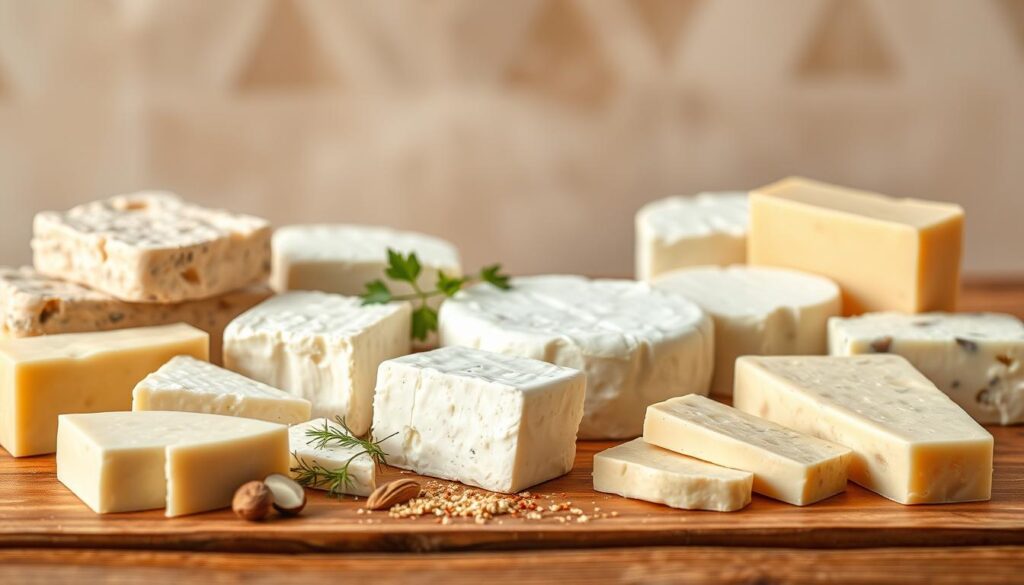Living with celiac disease or gluten sensitivity doesn’t mean giving up on tasty snacks. I learned that gluten free mozzarella sticks can be a lifesaver for those with dietary limits.
The world of gluten-free snacks has changed a lot in recent years. Now, you can enjoy classic appetizers without risking your health. The FDA helps by setting strict rules for food labels and safety.
For gluten-free mozzarella sticks, knowing what’s safe is key. People with gluten sensitivities need to watch out for hidden gluten in cheese. This guide will show you how to find safe, tasty cheese snacks.
Your health and love for food are important. By learning about safe ingredients and how they’re made, you can pick mozzarella sticks that are good for you. And they won’t lack in flavor.
Understanding Mozzarella Cheese Safety for Gluten-Sensitive Individuals
Finding the right cheese can be tough with dietary limits. Many wonder if mozzarella is safe for those with gluten sensitivities. It’s common to question cheese ingredients and gluten risks.

Knowing what’s in mozzarella is key for those with gluten issues. Real mozzarella doesn’t have gluten, making it a good choice for many with dietary restrictions.
Natural Mozzarella Composition
Traditional mozzarella has simple ingredients. These include:
- Milk
- Rennet
- Salt
- Bacterial cultures
Common Ingredients in Traditional Mozzarella
When looking at cheese alternatives, knowing mozzarella’s usual ingredients is important. Pure lactose-free mozzarella is great for those avoiding dairy but still want to eat safely.
Gluten Content Evaluation
Always check labels to stay safe. Some cheeses might have gluten from additives or how they’re made. Here’s what to do:
- Look for certified gluten-free labels
- Contact manufacturers directly
- Verify production facility practices
By knowing these tips, you can pick mozzarella or dairy-free cheese that fits your diet.
Essential Ingredients for Gluten Free Mozzarella Sticks

Making gluten-free mozzarella sticks is all about choosing the right ingredients. Start your journey to making great non-gmo appetizers by knowing the key ingredients. These ingredients make your snacks safe and delicious.
When picking ingredients for vegan mozzarella sticks, look for top-notch alternatives. These should offer great taste and texture. Your recipe should have:
- Gluten-free flour blends (like rice flour, almond flour, and cornstarch)
- Non-GMO breadcrumb alternatives
- Plant-based binding agents
- Dairy-free cheese substitutes
Binding agents are key in gluten-free recipes. They help your vegan mozzarella sticks stick together perfectly. Here are some good options:
| Binding Agent | Characteristics | Best Used With |
|---|---|---|
| Xanthan Gum | Excellent structural support | Gluten-free flour mixes |
| Flax Egg | Natural plant-based binder | Vegan mozzarella recipes |
| Chia Seeds | High protein binding properties | Non-gmo appetizers |
Choosing premium ingredients can elevate your non-gmo appetizers. They should meet dietary needs and taste amazing. Try different plant-based cheese alternatives to get the perfect texture and flavor for your gluten-free mozzarella sticks.
Pro tip: Always check ingredient labels to ensure complete allergen safety and non-GMO certification.
Safe Cheese Options and Alternatives
Finding cheese can be tough for people with dietary limits. Your search for tasty plant-based cheese sticks and allergy-friendly foods opens up new options. These options meet different nutritional needs.

Exploring cheese alternatives leads to many ways to enjoy your food. You can stay healthy and safe while satisfying your cravings.
Traditional Dairy Mozzarella Selections
If you can handle dairy, there are safe mozzarella choices:
- Low-lactose aged mozzarella varieties
- Fresh mozzarella with reduced lactose content
- Certified gluten-free dairy cheese options
Plant-Based Cheese Substitutes
Plant-based cheese sticks have changed allergy-friendly food with new options:
- Cashew-based mozzarella alternatives
- Almond milk cheese substitutes
- Coconut oil-based cheese products
Allergen-Free Certification Guidelines
Choosing safe cheese products means checking labels carefully. Look for:
- Verified gluten-free certifications
- Detailed ingredient transparency
- Third-party allergen testing verification
Pro tip: Always contact manufacturers directly if you have specific dietary concerns about their plant-based cheese sticks or dairy alternatives.
FDA Regulations for Allergen Labeling
When it comes to gluten-free party food, knowing FDA rules is key. The Food Allergen Labeling and Consumer Protection Act (FALCPA) helps keep people with dietary needs safe. It’s vital for those looking for clean eating snacks.
The FDA has strict labeling rules to help those with food allergies. These rules focus on eight major allergens. They make sure food packaging is clear about what’s inside.
“Knowledge is the first line of defense in managing food allergies and sensitivities.” – FDA Food Safety Guidelines
Key FDA Labeling Requirements
- Mandatory disclosure of all potential allergens
- Clear identification of gluten-containing ingredients
- Precise ingredient listing with common allergen names
- Warnings about potential cross-contamination
For makers of gluten-free party food, following these rules is a must. They must list all ingredients clearly. Only snacks that meet strict standards can get the official gluten-free label.
| Allergen Category | Labeling Requirement | Enforcement Level |
|---|---|---|
| Gluten | Must be explicitly stated | High |
| Wheat | Mandatory ingredient disclosure | High |
| Dairy | Complete ingredient transparency | High |
Knowing these rules helps you make better choices about what you eat. Always check labels and look for the official gluten-free label.
Cross-Contamination Risks in Cheese Processing
When making gluten free mozzarella sticks, it’s key to know about cross-contamination risks. This is to keep food safe. Cross contact occurs when allergen proteins move between foods, risking the safety of dairy-free cheese and other special foods.
Manufacturing places face big challenges in stopping allergen transfer by mistake. Many ways can lead to contamination.
Manufacturing Facility Concerns
Cheese making places have big risks of cross-contamination:
- Shared processing equipment
- Airborne particle transmission
- Employee handling procedures
- Ingredient storage proximity
Equipment used for different products can accidentally add gluten or dairy to allergen-free foods. Microscopic residue from previous production runs can stay, even after cleaning.
Prevention Strategies
To stop cross-contamination, we need strong plans:
- Dedicated production lines for gluten free mozzarella sticks
- Rigorous equipment sanitization
- Regular allergen testing
- Staff training on contamination risks
By using these steps, makers can keep food safe for those with dietary needs.
Reading and Understanding Cheese Product Labels
Looking for celiac-friendly snacks can be tough. It’s important to know how to read cheese labels. This is true for those who need lactose-free mozzarella and gluten-free options.
When you check cheese labels, you’ll see two main ways allergens are listed:
- Within the ingredient list
- Following a “Contains” statement
Here are some key things to look for:
- Ingredient transparency
- Allergen warnings
- Potential gluten sources
“Knowledge is power when it comes to reading food labels” – Nutrition Expert
| Label Component | What to Look For | Potential Risks |
|---|---|---|
| Ingredient List | Natural cheese ingredients | Hidden gluten additives |
| Allergen Statement | Clear dairy/gluten warnings | Cross-contamination risks |
| Certification Marks | Gluten-free certifications | Verified safe products |
If you have more than one dietary concern, examining labels carefully is key. Look for specific certifications that show your snacks are safe for your diet.
It’s crucial for manufacturers to clearly list allergens in lactose-free mozzarella and other cheeses. Your health depends on understanding these label details.
Identifying Hidden Sources of Gluten in Cheese Products
Finding gluten-free cheese can be hard for those with gluten sensitivities. Many people don’t know that vegan mozzarella and non-GMO appetizers might have hidden gluten. It’s important to know these risks to keep your diet safe and healthy.
Common Additives and Preservatives
Cheese products often have ingredients that can cause gluten problems. Be careful of these additives:
- Artificial colors
- Artificial flavors
- Maltodextrin
- Natural flavors
- Spices with potential gluten contamination
Modified Food Starches: A Hidden Danger
Modified food starches can be a big gluten risk in cheese products. They might come from wheat, barley, or rye, which is not safe for gluten-sensitive people. Always check the ingredient list for modified food starch when picking vegan mozzarella or non-GMO appetizers.
Anti-Caking Agents to Avoid
Anti-caking agents are another gluten risk. Some are made from wheat to stop clumping. To stay safe, look for clear labels and gluten-free certifications on cheese products.
Pro tip: Always contact manufacturers directly if you’re unsure about the gluten content of a specific product.
By being informed and careful, you can enjoy cheese products while keeping your diet gluten-free.
Safe Storage and Handling Practices
Keeping your clean eating snacks safe is key. When you make allergy-friendly food, it’s important to keep things clean. This helps avoid mixing foods that shouldn’t be together and keeps your food fresh.
Here are some important tips for storing gluten-free and allergen-friendly foods:
- Set aside a shelf in your fridge for allergy-friendly foods
- Use sealed containers to keep foods away from allergens
- Mark storage containers with when they were made and what’s in them
- Put gluten-free items where they won’t get mixed with other foods
Keeping your kitchen organized is vital for food safety. Having separate storage is not just a good idea—it’s a must for people with food allergies.
“Food safety starts with mindful storage and handling practices” – Nutrition Experts
It’s also important to keep food at the right temperature. Chill mozzarella sticks and other foods at 40°F or colder. Always use clean tools when handling these foods to avoid contamination.
- Keep your fridge at a steady cold temperature
- Use special cutting boards for foods without allergens
- Wash your hands well before cooking
By following these storage tips, you’ll keep your allergy-friendly food safe. This way, you can enjoy safe and tasty meals with everyone.
Kitchen Safety Protocols for Gluten Free Preparation
Preparing gluten-free food for parties needs careful attention. It’s important to avoid cross-contact, which is key for those with gluten sensitivities. This is true whether you’re making plant-based cheese sticks or traditional mozzarella.
Your kitchen is a key area for keeping food safe when making gluten-free snacks. By following certain protocols, you can protect those with dietary restrictions from contamination.
Equipment Sanitization Strategies
Cleaning well is the first step in safe gluten-free food prep. Here are some important steps:
- Wash all cooking utensils with hot, soapy water
- Use dedicated cutting boards for gluten-free ingredients
- Run equipment through high-temperature dishwasher cycles
- Sanitize surfaces with food-safe disinfectant solutions
Workspace Organization Techniques
A well-organized kitchen helps avoid cross-contamination when making gluten-free food.
| Workspace Area | Recommended Practice |
|---|---|
| Preparation Surfaces | Clean and designate specific zones for gluten-free cooking |
| Storage Areas | Separate gluten-free ingredients from standard products |
| Cooking Equipment | Use separate utensils and cookware for gluten-free meals |
Cross-Contact Prevention
Being careful is key when making plant-based cheese sticks or other gluten-free foods. Here are some steps to take:
- Wear clean gloves during food preparation
- Use separate cooking tools for gluten-free recipes
- Clean all surfaces thoroughly before starting
- Store gluten-free ingredients in sealed containers
“Safety in the kitchen starts with awareness and systematic approach.” – Culinary Food Safety Expert
By following these kitchen safety tips, your gluten-free party food will be safe, tasty, and fun for everyone.
Quality Assurance and Third-Party Testing
Ensuring the safety of non-GMO appetizers and celiac-friendly snacks is crucial. Food makers use advanced testing to keep products safe for those with dietary needs.
The FDA uses top-notch testing to check if products are gluten-free. They focus on:
- Enzyme-Linked Immunosorbent Assay (ELISA) testing
- Antibody-based allergen detection
- Molecular diagnostic screening
Third-party testing labs are key in checking snack safety. They offer unbiased checks on food products. This helps people make better choices.
Non-GMO appetizer makers go through many steps:
- Initial ingredient screening
- Production facility inspection
- Comprehensive allergen testing
- Final product certification
Transparency is key to building trust. Clear testing reports and labels help people with dietary needs choose safely.
Accurate testing protects consumer health and ensures food safety standards are consistently met.
Investing in quality assurance shows food makers’ dedication. They aim to provide safe, reliable products for those with special dietary needs.
Government Monitoring and Compliance Measures
Keeping gluten free mozzarella sticks and allergy-friendly food safe is a big job. The Food and Drug Administration (FDA) is key in this effort. They use detailed monitoring systems to protect people with food allergies.
The FDA has a strong Consumer Complaint System. It tracks any food allergy issues. This helps spot problems in food making, which is important for those with gluten sensitivities.
- Continuous tracking of food allergy reports
- Detailed investigation of ingredient safety
- Regular inspection of food manufacturing facilities
Companies making allergy-friendly food must follow strict rules. These rules make sure gluten free mozzarella sticks are safe and healthy before they hit the market.
| Monitoring Focus Area | Key Compliance Measures |
|---|---|
| Ingredient Verification | Comprehensive ingredient testing |
| Cross-Contamination Prevention | Strict facility sanitization protocols |
| Labeling Accuracy | Mandatory allergen disclosure requirements |
Companies must take steps to keep consumers safe. They need to document everything, have regular checks, and be open about their practices. This helps keep food safe for everyone.
The FDA’s strict monitoring helps people with special diets feel safe. They can enjoy tasty, safe food without worry.
Conclusion
Making safe and tasty gluten-free party food needs careful attention. Your journey starts with knowing where ingredients come from and how they’re made. You also need to watch out for cross-contamination risks.
Both manufacturers and home cooks must read labels carefully and check ingredients. They also need to follow strict kitchen rules. Knowing about FDA rules and third-party tests helps you pick safe mozzarella sticks.
Gluten-free food is more than avoiding allergens. It’s about making food that everyone can enjoy. By understanding ingredients, checking labels, and keeping things clean, you can make snacks that are both safe and delicious.
Knowledge is key in gluten-free cooking. With research, careful prep, and a love for good food, you can make mozzarella sticks and snacks that everyone can safely enjoy.
FAQ
Are mozzarella sticks naturally gluten-free?
What are the best gluten-free alternatives for breading mozzarella sticks?
How can I prevent cross-contamination when making gluten-free mozzarella sticks?
Are all cheeses naturally gluten-free?
What dairy-free alternatives work best for mozzarella sticks?
How do I know if a product is truly gluten-free?
Can people with celiac disease safely eat mozzarella?
Are vegan mozzarella sticks typically gluten-free?
What cooking methods are best for gluten-free mozzarella sticks?
There are no reviews yet. Be the first one to write one.



